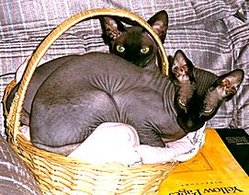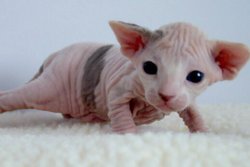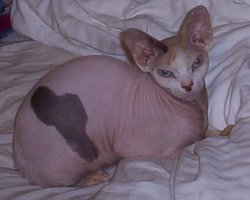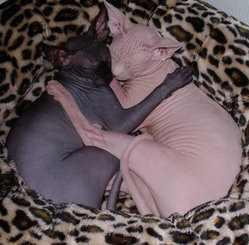

Custom Search
|

The Sphynx (aka Canadian Hairless) is a rare breed of cat with extremely little fur, or at most a short fuzz over its body, and no whiskers (vibrissae). Their skin is the color their fur would be, and all the usual cat marking patterns (solid, point, van, tabby, tortie, etc) may be found in Sphynx too. They are sometimes mistaken for Chihuahuas because of their extremely unusual and, some say, uncatlike appearance. They are very affectionate and extroverted and like to cuddle with their humans, other humans, and each other.
 Sphynx Kitten - 2 Weeks
Sphynx Kitten - 2 Weeks
Delicate as they may appear, Sphynx tend to be well-muscled and robustly healthy, with a few obvious weaknesses. It is essential to keep a sphynx cat warm and free from drafts, especially during kittenhood, as they have no more protection from cold than a naked human would. Sphynxes are also prone to sunburn and sunstroke because they lack the normal protection of fur. They tend to get dirty and greasy, since their skin produces the same oils as a fully-furred cat, but the oil is not spread over fur as usual. As pets they are notably more social than normal cats, and happier to be handled, but also require more maintenance including weekly bathing and ear-cleaning. Their natural bathing habits tend to be ineffective on skin, so the owner must compensate a bit.



Sphynx cats are not hypoallergenic[1], in fact they can be even worse for severely allergic people than furred cats. But because they don't deposit hair on furniture or clothing, they tend to be easier to clean up after, and therefore often less troublesome to mildly allergic owners. A large number of individuals allergic to cats can live with Sphynx cats without experiencing any form of allergy. Some notice symptoms but handle it by bathing and cleaning them slightly more often than one would otherwise. Allergic people often bathe and clean their Sphynx cats every 5 - 7 days, while others do it roughly every two weeks or when needed.
Although hairless cats have been reported throughout history (hairless cats seem to appear naturally about every 15 years or so), and breeders in Canada have been working on the Sphynx breed since the early 1960's, the current American and European Sphynx breed is descended from two lines of natural mutations:
The Sphynx breed is known for a sturdy, heavy body, a wedge-shaped head, and an alert, friendly temperament. A cat being hairless is not necessarily a Sphynx! Other hairless breeds might have different body shapes or temperaments than those described above. There are, for example, new hairless breeds, including the Don Sphynx and the Peterbald from Russia, which arose from their own spontaneous mutations. The standard for the Sphynx differs between TICA and FIFE.
Sphynx hairlessness is produced by an allele of the same gene that produces the Devon Rex, which has only one of the usual two fur coats. The Sphynx allele is incompletely dominant over the Devon allele; both are recessive to the wild type. Sphynx were at one time crossbred with Devon Rex in an attempt to strengthen this gene, but unfortunately this led to serious dental or nervous-system problems and is now forbidden in most breed standards associations. The only allowable outcross breeds in the CFA are now the American Shorthair and Domestic Shorthair. Other associations have different rules. In Europe mainly Devon Rex has been used for outcrosses.
A well-known Sphynx is SGC Belfry Ted Nude-Gent who is in the Austin Powers movies. He plays the part of Mr. Bigglesworth, Dr. Evil's cat.
A Sphynx was to star in Harry Potter, but the scene was cut due to time constraints.
Cats, made by MultiMedia | Free content and software
This guide is licensed under the GNU Free Documentation License. It uses material from the Wikipedia.